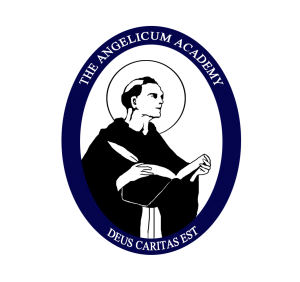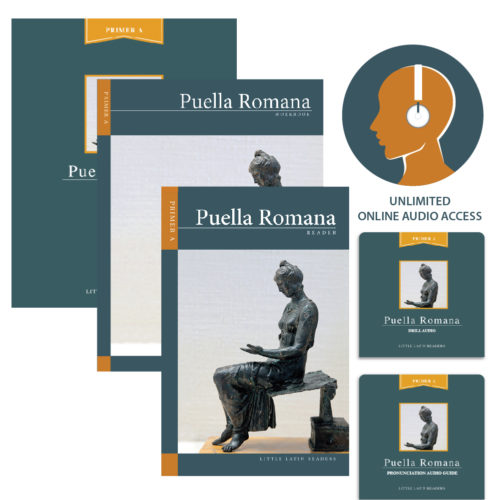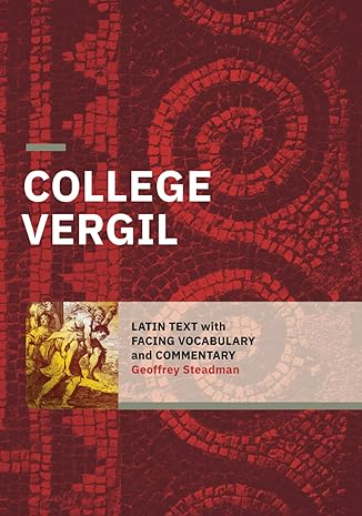Authentic Classical Education with all Timeless Ten© Elements
Live, Online Latin Classes
Please select the grade level that you would like to learn about:
Latin Grades 1-3: Primer A
Latin Grades 2-4: Primer B & C
Latin Grades 4-6: Liber Primus
Latin Grades 5-7: Liber Secundus
Latin Grades 6-8: Liber Tertius
Latin Grades 8-12: Sancta Missa
Latin Grades 9-12: First Year Latin for High School
Latin Grades 9-12: Classical Latin 1
Latin Grades 9-12: Classical Latin 2
Latin Grades 9-12: Classical Latin 3
Latin Grades 9-12: Classical Latin 4
Live Class Payment in Full
- 5% Payment in Full Discount = $565.25
Live Class Payment Plan
- $59.50/mo for 10 Months
Latin Grades 1-3: Primer A
(Recommended for students in grades 1-3 with no experience in Latin. Multiple class times may be offered for younger and older grades. Check back here for details.)
Liber Primer A: Puella Romana Complete Set
The beginning level reader, Puella Romana, (The Roman Girl) introduces the student to simple Latin sentences and short paragraphs with stories from the life of a girl in ancient Rome. First declension feminine nouns are used in sentences with simple third person being verbs and intransitive verbs in the present tense. Prepositional phrases with in and ad and adjective phrases are also introduced. Ideal for beginning students of all ages. Drill book with enrichment exercises especially recommended for students in grades 3 and up.
The beginning level Puella Romana Complete Set includes the Puella Romana Reader, Workbook, Drill Book, Pronunciation Audio Guide, and Pronunciation/Drill Audio Guide for the Drill Book.
The Puella Romana Drill Book (8 1/2″ x 11″) features lessons corresponding with the workbook lessons providing additional exercises and more in-depth explanations of the grammar concepts introduced in the workbook. Each lesson begins with the student copying in cursive all essential grammar definitions and rules. English cognates derived from the featured vocabulary words are given to help the student learn to recognize Latin roots in English words.
Short sentences with first declension nouns taken from the Latin Vulgate Bible, the Liber Usualis or the writings of the saints are presented as models for the student to copy and memorize if desired.
The accompanying audio guide aids the student in memorizing the grammar rules and definitions and in learning the correct pronunciation of the Latin.
Dates: This weekly, one-hour, live class begins the first week of September. Classes are 30 weeks (15 weeks per semester).
For dates and holidays, see the Academic Calendar.
Latin Grades 2-4: Primer B & Primer C
(Recommended for students in grades 2-4)
Description of Primer B: Compared to Primer A, Britanni et Galli introduces the student to slightly more difficult Latin sentences and longer paragraphs in engaging illustrated stories about the inhabitants of ancient Britain and Gaul. Second declension masculine and neuter nouns are used in sentences with simple third person being verbs and intransitive verbs in the present tense. The genitive case of the first and second declension and the use of nouns of possession are introduced. The student will learn more prepositions and a rich variety of new vocabulary words. Short sentences with first declension nouns are taken from the Latin Vulgate Bible, the Liber Usualis, and writings of the saints. Little Latin Readers provides Catholics with a solid foundation in the sacred language of their faith.
Description of Primer C: Compared to Primer B, Civitates Europae features longer, and more complex sentences with relative and subordinate clauses and ablative absolutes. Deponent verbs and verbs in the passive voice are introduced along with infinitive gerunds and participles. The stories feature the geographical and historical significance of several European countries and highlight the lives of important characters in medieval Europe. With each lesson, the student is given a related Latin sentence from the Vulgate Bible, and will learn several new Latin prayers over the course of the year. A special feature of this level is the exploration of the Latin titles of the scenes in the Bayeux Tapestry.
Required Textbooks: Latin Primer B: Britanni et Galli & Latin Primer C: Civitates Europae
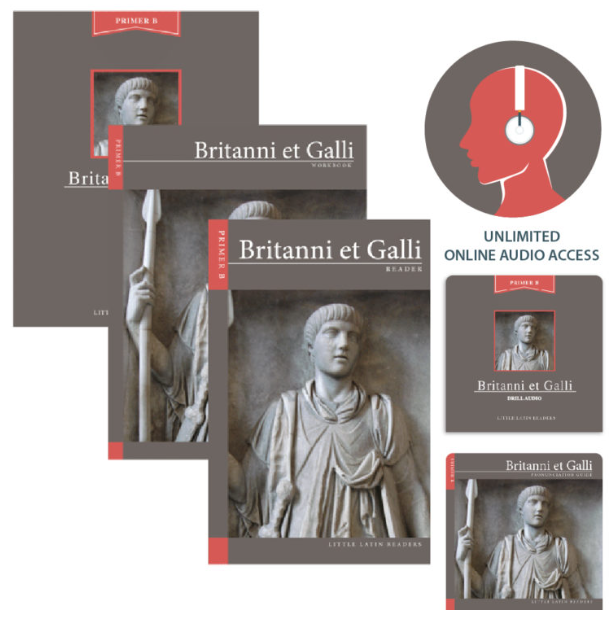 The Primer B Britanni et Galli (The Britons and Gauls) Complete Set includes the Britanni et Galli Reader, Workbook, Pronunciation Audio for the reader, and Drill Book with companion Pronunciation/Drill Audio. The Britanni et Galli Reader introduces the student to slightly more difficult Latin sentences and longer paragraphs in engaging illustrated stories about the inhabitants of ancient Britain and Gaul. Second declension masculine and neuter nouns are used in sentences with simple third person being verbs and intransitive verbs in the present tense. The genitive case of the first and second declension and the use of nouns of possession are introduced. The student will learn more prepositions and a rich variety of new vocabulary words. The Britanni et Galli Workbook activities direct the student to modify second declension masculine and neuter nouns with adjectives. He/she will also learn singular and plural endings for the nominative, genitive, accusative and ablative cases, achieve a solid understanding of various noun functions, study the three genders of nouns, and have many chances to identify these important sentence elements: subject, predicate nominative, predicate adjective, nouns of possession, prepositional phrases, adjective phrases, being verbs and transitive verbs. The Britanni et Galli Drill Book (8 1/2″ x 11″) features lessons corresponding with the workbook lessons providing additional exercises and more in-depth explanations of the grammar concepts introduced in the workbook. Each lesson begins with the student copying in cursive all essential grammar definitions and rules. English cognates derived from the featured vocabulary words are given to help the student learn to recognize Latin roots in English words. The accompanying Pronunciation Audio for the reader and the Pronunciation/Drill Audio aid the student in memorizing the grammar rules and definitions and in learning the correct pronunciation of the Latin.
The Primer B Britanni et Galli (The Britons and Gauls) Complete Set includes the Britanni et Galli Reader, Workbook, Pronunciation Audio for the reader, and Drill Book with companion Pronunciation/Drill Audio. The Britanni et Galli Reader introduces the student to slightly more difficult Latin sentences and longer paragraphs in engaging illustrated stories about the inhabitants of ancient Britain and Gaul. Second declension masculine and neuter nouns are used in sentences with simple third person being verbs and intransitive verbs in the present tense. The genitive case of the first and second declension and the use of nouns of possession are introduced. The student will learn more prepositions and a rich variety of new vocabulary words. The Britanni et Galli Workbook activities direct the student to modify second declension masculine and neuter nouns with adjectives. He/she will also learn singular and plural endings for the nominative, genitive, accusative and ablative cases, achieve a solid understanding of various noun functions, study the three genders of nouns, and have many chances to identify these important sentence elements: subject, predicate nominative, predicate adjective, nouns of possession, prepositional phrases, adjective phrases, being verbs and transitive verbs. The Britanni et Galli Drill Book (8 1/2″ x 11″) features lessons corresponding with the workbook lessons providing additional exercises and more in-depth explanations of the grammar concepts introduced in the workbook. Each lesson begins with the student copying in cursive all essential grammar definitions and rules. English cognates derived from the featured vocabulary words are given to help the student learn to recognize Latin roots in English words. The accompanying Pronunciation Audio for the reader and the Pronunciation/Drill Audio aid the student in memorizing the grammar rules and definitions and in learning the correct pronunciation of the Latin.
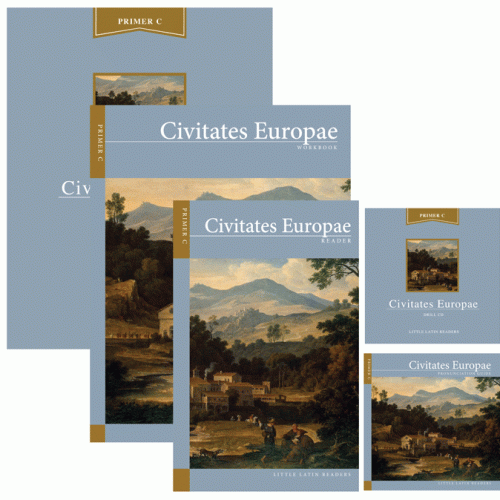 The Primer C Civitates Europae (The States of Europe) Complete Set includes the Civitates Europae Reader, Civitates Europae Workbook, Civitates Europae Pronunciation Audio for the reader, Civitates Europae Drill Book with companion Civitates Europae Drill Book Audio. Ideal for students who have completed Primer A Puella Romana and Primer B Britanni et Galli. The third primer, Civitates Europae Reader, features brief and informative descriptions of the geography and history of several European countries. Some new first and second declension nouns are introduced but the main emphasis is on learning third declension nouns. Several new prepositions are added as well as the continued use of adjective phrases and genitive phrases. The student will also have the opportunity to learn the Latin names and geographical location of most of the countries of Europe. The accompanying Civitates Europae Workbook reviews the first two declensions and discusses third declension nouns in all three genders, including a brief discussion of third declension I-stem nouns. The student will learn to decline nouns in all declensions in the nominative, genitive, accusative and ablative cases. Extensive work with noun functions and the identification of sentence elements is featured along with numerous drills for mastery in vocabulary. The Civitates Europae Drill Book (8 1/2″ x 11″) features lessons corresponding with the workbook lessons providing additional exercises and more in-depth explanations of the grammar concepts introduced in the workbook. Each lesson begins with the student copying in cursive all essential grammar definitions and rules. English cognates derived from the featured vocabulary words are given to help the student learn to recognize Latin roots in English words. The accompanying Civitates Europae Pronunciation Audio provides a professional narration of the reading selections in the reader and correct pronunciation of all vocabulary words. The Civitates Europae Drill Book Audio aids the student in memorizing the grammar rules, definitions and drills and in learning the correct pronunciation of the Latin.
The Primer C Civitates Europae (The States of Europe) Complete Set includes the Civitates Europae Reader, Civitates Europae Workbook, Civitates Europae Pronunciation Audio for the reader, Civitates Europae Drill Book with companion Civitates Europae Drill Book Audio. Ideal for students who have completed Primer A Puella Romana and Primer B Britanni et Galli. The third primer, Civitates Europae Reader, features brief and informative descriptions of the geography and history of several European countries. Some new first and second declension nouns are introduced but the main emphasis is on learning third declension nouns. Several new prepositions are added as well as the continued use of adjective phrases and genitive phrases. The student will also have the opportunity to learn the Latin names and geographical location of most of the countries of Europe. The accompanying Civitates Europae Workbook reviews the first two declensions and discusses third declension nouns in all three genders, including a brief discussion of third declension I-stem nouns. The student will learn to decline nouns in all declensions in the nominative, genitive, accusative and ablative cases. Extensive work with noun functions and the identification of sentence elements is featured along with numerous drills for mastery in vocabulary. The Civitates Europae Drill Book (8 1/2″ x 11″) features lessons corresponding with the workbook lessons providing additional exercises and more in-depth explanations of the grammar concepts introduced in the workbook. Each lesson begins with the student copying in cursive all essential grammar definitions and rules. English cognates derived from the featured vocabulary words are given to help the student learn to recognize Latin roots in English words. The accompanying Civitates Europae Pronunciation Audio provides a professional narration of the reading selections in the reader and correct pronunciation of all vocabulary words. The Civitates Europae Drill Book Audio aids the student in memorizing the grammar rules, definitions and drills and in learning the correct pronunciation of the Latin.
The live classes supplement homeschool study. We will prepare for assignments and resolve issues with previous assignments; practice exercises and pronunciation; go over grammar rules and vocabulary; discuss sacred significances; learn some prayers of the Rosary in Latin; use a little conversational Latin; and discover Gregorian chant.
Dates: This weekly, one-hour, live class will meet beginning the first week of September. Classes are 30 weeks (15 weeks per semester). For dates and holidays, see the Academic Calendar.
Latin Grades 4-6: Liber Primus
(Recommended for students in grades 4-6 who have some previous experience with Latin)
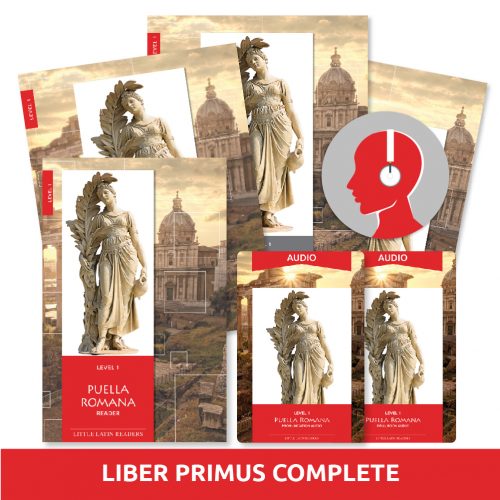 The live classes supplement homeschool study. We will prepare for assignments and resolve issues with previous assignments; practice exercises and pronunciation; go over grammar rules and vocabulary; discuss sacred significances; learn some prayers of the Rosary in Latin; use a little conversational Latin; and discover Gregorian chant.
The live classes supplement homeschool study. We will prepare for assignments and resolve issues with previous assignments; practice exercises and pronunciation; go over grammar rules and vocabulary; discuss sacred significances; learn some prayers of the Rosary in Latin; use a little conversational Latin; and discover Gregorian chant.
Required text: Liber Primus, first level, Puella Romana Complete Set includes the Puella Romana Reader with Pronunciation Companion Audio, Workbook, Drill Book, Drill Book Companion Audio, and a Teacher’s Guide of Lesson Plans, Tests and Answer Keys. This set provides all the tools you need to starting teaching your young students Latin language while instilling a faith-based Catholic foundation. Little Latin readers offers a strong and thorough curriculum for both homeschool and traditional classroom settings.
The Puella Romana Drill Book (8 1/2″ x 11″) features lessons corresponding with the workbook lessons providing additional exercises and more in-depth explanations of the grammar concepts introduced in the workbook. Each lesson begins with the student copying in cursive all essential grammar definitions and rules. English cognates derived from the featured vocabulary words are given to help the student learn to recognize Latin roots in English words.
Short sentences with first declension nouns taken from the Latin Vulgate Bible, the Liber Usualis or the writings of the saints are presented as models for the student to copy and memorize if desired.
The Companion Audio lessons aid the student in memorizing the grammar rules and definitions and in learning the correct pronunciation of the Latin.
This weekly, one-hour, live class will meet beginning the first week of September. Classes are 30 weeks (15 weeks per semester). For dates and holidays, see the Academic Calendar.
Latin Grades 5-7: Liber Secundus
(Recommended for students in grades 5-7 who have some previous experience with Latin.)
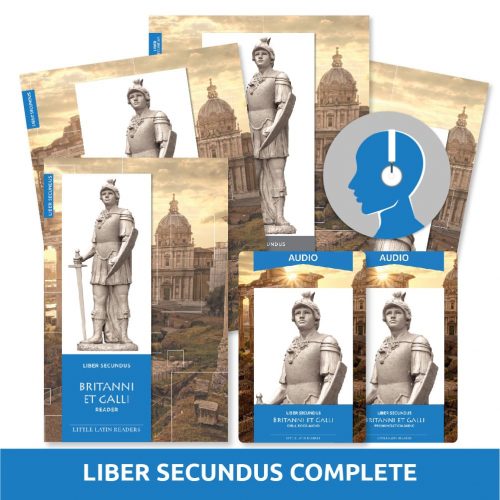 Required Textbook: Liber Secundus, level 2, Britanni et Galli (The Britons and Gauls) includes the Britanni et Galli Reader, Workbook, Pronunciation Audio for the reader, Drill Book with Companion Audio and a detailed Teacher’s Manual of lesson plans, tests and answer keys.
Required Textbook: Liber Secundus, level 2, Britanni et Galli (The Britons and Gauls) includes the Britanni et Galli Reader, Workbook, Pronunciation Audio for the reader, Drill Book with Companion Audio and a detailed Teacher’s Manual of lesson plans, tests and answer keys.
The Britanni et Galli Reader (5 1/2″ x 8 1/2″) introduces the student to slightly more difficult Latin sentences and longer paragraphs in engaging illustrated stories about the inhabitants of ancient Britain and Gaul. Second declension masculine and neuter nouns are used in sentences with simple third person being verbs and intransitive verbs in the present tense. The genitive case of the first and second declension and the use of nouns of possession are introduced. The student will learn more prepositions and a rich variety of new vocabulary words.
The Britanni et Galli Workbook (8 1/2″ x 11″) activities direct the student to modify second declension masculine and neuter nouns with adjectives. He/she will also learn singular and plural endings for the nominative, genitive, accusative and ablative cases, achieve a solid understanding of various noun functions, study the three genders of nouns, and have many chances to identify these important sentence elements: subject, predicate nominative, predicate adjective, nouns of possession, prepositional phrases, adjective phrases, being verbs and transitive verbs.
The Britanni et Galli Drill Book (8 1/2″ x 11″) features lessons corresponding with the workbook lessons providing additional exercises and more in-depth explanations of the grammar concepts introduced in the workbook. Each lesson begins with the student copying in cursive all essential grammar definitions and rules. English cognates derived from the featured vocabulary words are given to help the student learn to recognize Latin roots in English words.
Short sentences with first declension nouns taken from the Latin Vulgate Bible, the Liber Usualis or the writings of the saints are presented as models for the student to copy and memorize if desired.
The accompanying Pronunciation Companion Audio for the reader and the Drill Book Companion Audio aid the student in memorizing the grammar rules and definitions and in learning the correct pronunciation of the Latin.
The live classes supplement homeschool study. We will prepare for assignments and resolve issues with previous assignments; practice exercises and pronunciation; go over grammar rules and vocabulary; discuss sacred significances; learn some prayers of the Rosary in Latin; use a little conversational Latin; and discover Gregorian chant.
Dates: This weekly, one-hour, live class will meet beginning the first week of September. Classes are 30 weeks (15 weeks per semester). For dates and holidays, see the Academic Calendar.
Latin Grades 6-8: Liber Tertius
(Recommended for students in grades 6-8 who have previously studied some Latin.)
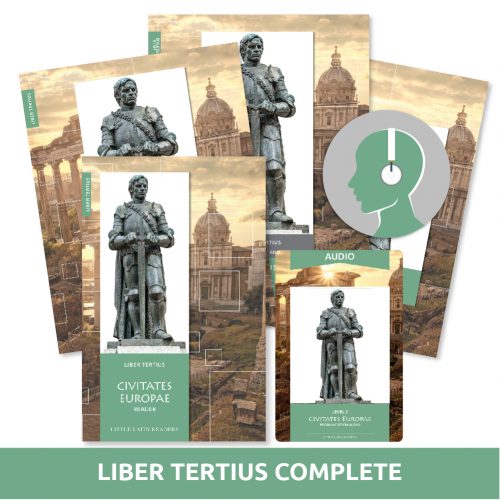 Required Textbook: Complete Set of Liber Tertius Civitates Europae (The States of Europe) includes the Civitates Europae Reader, Workbook, Pronunciation Audio for the reader, Drill Book and a detailed Teacher’s Manual of lesson plans, tests and answer keys.
Required Textbook: Complete Set of Liber Tertius Civitates Europae (The States of Europe) includes the Civitates Europae Reader, Workbook, Pronunciation Audio for the reader, Drill Book and a detailed Teacher’s Manual of lesson plans, tests and answer keys.
The Liber Tertius Civitates Europae Reader (5 1/2″ x 8 1/2″) features longer, and more complex sentences with relative and subordinate clauses and ablative absolutes. Deponent verbs and verbs in the passive voice are introduced along with infinitive gerunds and participles. The stories feature the geographical and historical significance of several European countries and highlight the lives of important characters in medieval Europe.
The Liber Tertius Workbook provides the student with extensive practice with nouns of all five declensions in five cases. Students will learn to identify the four conjugations of verbs and will work with verbs in three tenses as well as with deponent verbs and verbs in the passive voice. Students will be introduced to the four principal parts of verbs and will learn to recognize infinitives, gerunds and participles. The student will work with various types of pronouns and adjectives. Different uses of the ablative and the locative will be introduced, and the student will work with Latin cardinal numbers from 1-1000, especially as they are used in dates. The student will learn several common verb constructions and will begin diagramming sentences.
The Liber Tertius Civitates Drill Book (8 1/2″ x 11″) gives the student additional practice with the core vocabulary words and with different forms of the verbs used in the reader, including first and second person verbs. English cognates of the Latin vocabulary are given for every lesson, in addition to expanded explanations of certain key words, terms and items of interest mentioned in the reader. With each lesson the student is given a related Latin sentence from the Vulgate Bible, and will learn several new Latin prayers over the course of the year. A special feature of this level is the exploration of the Latin titles of the scenes in the Bayeux Tapestry.
The Liber Tertius Civitates Europae Teacher’s Guide includes detailed weekly lesson plans for a five-day week based on a thirty-six week school year, along with quizzes, quarterly tests and semester exams and Answer Key. In addition, to aid with organization, check off boxes are given for all assignments to help track student progress during the week. Percentages are given for all assignments and tests for grading purposes.
The accompanying online Pronunciation Companion Audio for the reader and the Drill Book Companion Audio aid the student in providing a correct pronunciation for all the words and Latin sentences. Additionally, they are invaluable for memorizing the grammar rules and definitions as well as being a recitation model of the grammar drills.
The live classes supplement homeschool study. We will prepare for assignments and resolve issues with previous assignments; practice exercises and pronunciation; go over grammar rules and vocabulary; discuss sacred significances; learn the Rosary in Latin; use a little conversational Latin; and discover Gregorian chant.
This weekly, one-hour, live class will meet beginning the first week of September. Classes are 30 weeks (15 weeks per semester). For dates and holidays, see the Academic Calendar.
Latin Grades 8-12: Sancta Missa
(Recommended for students in grades 8-12 who have previously studied Latin grammar, including some verbs and the first three declensions)
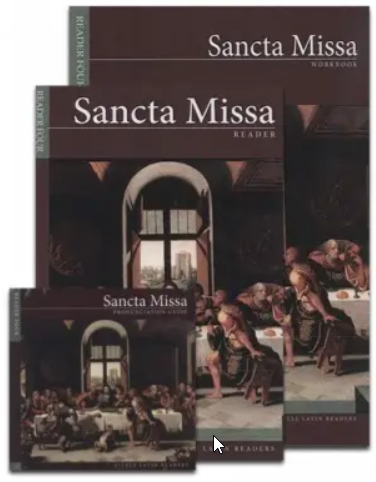
Prerequisite: Students will benefit from having completed Liber Tertius, but Liber Secundus or the equivalent is sufficient.
This course has a special focus on the application of Latin to understanding the Liturgy, and students regularly participate in class discussions. The live classes supplement homeschool study. We will prepare for assignments and resolve issues with previous assignments; practice exercises and pronunciation; go over grammar rules and vocabulary; discuss sacred significances; learn the Rosary in Latin; use a little conversational Latin; and discover Gregorian chant.
This course fulfills a year of high school foreign language. Drawing upon the writings of the saints and the work of Rev. Nicholas Gihr, Sancta Missa, the most advanced of the Little Latin Readers, presents Latin according to its most sacred and highest end: the Holy Mass. Assuming familiarity with the first three declensions and verbs, students study 4th and 5th declension nouns, verbs using the dative case, and the use of appositives in the nominative and accusative case. Upon completion, students are prepared for Henle I or the equivalent.
Required texts: Sancta Missa Set. This set includes the Sancta Missa Reader, Sancta Missa Workbook, and Sancta Missa Pronunciation Audio. The Sancta Missa Reader presents a brief examination of the Catholic Mass in illustrated articles and excerpts from the writings of the saints, drawing from the monumental study of the Mass, The Holy Sacrifice of the Mass; Dogmatically, Liturgically and Ascetically Explained” by the Rev. Nicholas Gihr. Along with familiar nouns of the first three declensions, the student will learn some fourth and fifth declension nouns. Verbs that use the dative case will be featured as well as the use of appositives in the nominative and accusative case. 58 pages. Small format (5-1/2″ x 8-1/2″). Translations included. Illustrated. 2nd Edition.
In the companion Sancta Missa Workbook, the student will review the first three declensions of nouns and learn nouns of the fourth and fifth declensions. Declension charts of nouns in all five cases as well as declension of adjective phrases will continue. Nouns in apposition will be studied along with third declension adjectives. The student will also have practice in parsing, a useful method of analyzing components of a Latin sentence. The workbook gives more in-depth explanations of the grammar and provides plenty of exercises and drills of grammar concepts, including much practice in diagramming sentences.
The Sancta Missa Pronunciation Audio includes the correct pronunciation for all the words presented in this level.
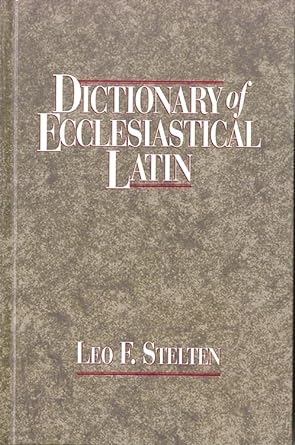 Dictionary of Ecclesiastical Latin. The Dictionary of Ecclesiastical Latin includes approximately 17,000 words with the common meanings of the Latin terms found in church writings. Entries cover Scripture, Canon Law, the Liturgy, Vatican II, the early church fathers, and theological terms. An appendix provides descriptions of ecclesiastical structures and explains technical terms from ecclesiastical law. The Dictionary of Ecclesiastical Latin has already been widely praised for its serviceability and indispensability in both academic and Church settings and will prove to be an invaluable resource for theological students and for those seeking to improve their knowledge of ecclesiastical Latin.
Dictionary of Ecclesiastical Latin. The Dictionary of Ecclesiastical Latin includes approximately 17,000 words with the common meanings of the Latin terms found in church writings. Entries cover Scripture, Canon Law, the Liturgy, Vatican II, the early church fathers, and theological terms. An appendix provides descriptions of ecclesiastical structures and explains technical terms from ecclesiastical law. The Dictionary of Ecclesiastical Latin has already been widely praised for its serviceability and indispensability in both academic and Church settings and will prove to be an invaluable resource for theological students and for those seeking to improve their knowledge of ecclesiastical Latin.
The live classes supplement homeschool study. We will prepare for assignments and resolve issues with previous assignments; practice exercises and pronunciation; go over grammar rules and vocabulary; discuss sacred significances; learn the Rosary in Latin; use a little conversational Latin; and discover Gregorian chant.
This weekly, one-hour, live class will meet beginning the first week of September. Classes are 30 weeks (15 weeks per semester). For dates and holidays, see the Academic Calendar.
Latin Grades 9-12: First Year Latin for High School
(Recommended for students in grades 9-12)
Prerequisite: Students will benefit from having completed Sancta Missa.
This course is intended to follow after the Sancta Missa. This course focuses on the Latin vocabulary and conventions in use by the Church after c. A.D. 300. Although the Latin language was the same both and before after 300 A.D., the pronunciation, vocabulary, subject matter, style, role, and time period differ from that of the Latin in classical antiquity. This course can be pared with our Great Books program particularly in the Romans year. Students will learn from the reading and study of both Church Latin authors studied in the second year of the Great Books program. The primary goal is for students to read and appreciate significant works of Church Latin authors as found in their original works. In the Great Books program students study excellent translations of these works but the study of the original works enables direct access to the thoughts and feelings of the authors themselves. In this course, the students learn and practice the Ecclesiastical pronunciation of Latin through the study of select excerpts from Sacred Scripture and well-known Catholic authors whose works are a major part of the Romans Great Books year. This course therefor follows the authentic 2,000 year practice of Church classical education integrating Church authors and using their works to teach Latin. Accordingly, students will study grammar, read out loud, memorize key passages, and learn Latin not only based on the Henle grammar but on excerpts taken from:
- Old Testament (including the Psalms)
- New Testament
- St. Jerome
- St. Augustine
- St. Ambrose
- St. Albert the Great
- St. Thomas Aquinas
- Venerable Bede
- St. Isidore of Seville
- Tertullian
- St. Benedict of Nursia
- Gregorian Chants
- Key passages from Church Councils
Required texts:
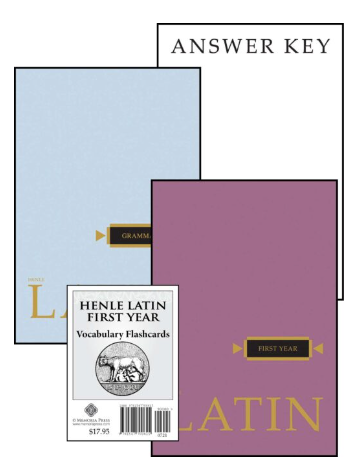 Henle Latin First Year Set: This basic set includes the Henle Latin First Year Text, Latin First Year Answer Key, Henle Latin First Year Vocabulary Flashcards, and Latin Grammar, the last of which is used with all four Henle Latin texts. Henle is a Catholic text known for its superiority as a teaching resource with an outstanding Christian perspective.
Henle Latin First Year Set: This basic set includes the Henle Latin First Year Text, Latin First Year Answer Key, Henle Latin First Year Vocabulary Flashcards, and Latin Grammar, the last of which is used with all four Henle Latin texts. Henle is a Catholic text known for its superiority as a teaching resource with an outstanding Christian perspective.
In the Henle Series, grammar and syntax are collected into a separate 250-page Grammar Manual, which is used as a handy reference to accompany all four years of Henle. The Henle texts contain all of the exercises and readings. In the First Year text, a limited vocabulary of 500 words allows students to master grammar without being overwhelmed with a large vocabulary. Many repetitious Latin phrases and copious exercises produce mastery rather than frustration, and the mixture of Christian and classical content is appealing to students. Exercises and readings teach Roman and American history, the difference between the pagan and Christian worldviews, and the difference between the virtues of the natural man (of whom the Roman was the greatest type) and the virtues of the Christian man, which are possible only through grace.
 Dictionary of Ecclesiastical Latin. The Dictionary of Ecclesiastical Latin includes approximately 17,000 words with the common meanings of the Latin terms found in church writings. Entries cover Scripture, Canon Law, the Liturgy, Vatican II, the early church fathers, and theological terms. An appendix provides descriptions of ecclesiastical structures and explains technical terms from ecclesiastical law. The Dictionary of Ecclesiastical Latin has already been widely praised for its serviceability and indispensability in both academic and Church settings and will prove to be an invaluable resource for theological students and for those seeking to improve their knowledge of ecclesiastical Latin.
Dictionary of Ecclesiastical Latin. The Dictionary of Ecclesiastical Latin includes approximately 17,000 words with the common meanings of the Latin terms found in church writings. Entries cover Scripture, Canon Law, the Liturgy, Vatican II, the early church fathers, and theological terms. An appendix provides descriptions of ecclesiastical structures and explains technical terms from ecclesiastical law. The Dictionary of Ecclesiastical Latin has already been widely praised for its serviceability and indispensability in both academic and Church settings and will prove to be an invaluable resource for theological students and for those seeking to improve their knowledge of ecclesiastical Latin.
The live classes supplement homeschool study. We will prepare for assignments and resolve issues with previous assignments; practice exercises and pronunciation; go over grammar rules and vocabulary; discuss sacred significances; learn the Rosary in Latin; use a little conversational Latin; and discover Gregorian chant.
This weekly, one-hour, live class will meet beginning the first week of September. Classes are 30 weeks (15 weeks per semester). For dates and holidays, see the Academic Calendar.
Latin Grades 9-12 – Classical Latin 1
For high school students
Prerequisite: Students will benefit from having completed Sancta Missa.
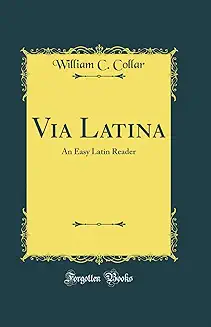 This course is intended to be a companion to our Great Books courses particularly in the first and second years (Ancient Greeks and Ancient Romans). In this first year High School Classical Latin course students will not only learn Classical Pr0nunication but also benefit from reading and study of secular Greek authors most of whom are studied in the first and second year of the Great books program. This course integrates excerpts from secular Greek authors. The readings covered include Cicero of 1st century A.D. who represented the height of rhetoric and combined the Roman spirit with Greek doctrine relying on many examples drawn from Greek authors studied during our Ancient Greek years. Cicero’s works were highly regarded and studied in the Church Cathedral schools and Medieval universities of the 12th and 13th centuries; the Renaissance, the Counter Reformation and American Colleges through the late 19th century. Similarly well-regarded and studied during these periods were Vergil’s works (Aeneid, Eclogues, Georgics), as well as Julius Caesar’s Conquest of Gaul. Both of these authors are read and studied during our Great Books Ancient Romans year. Accordingly, this course is classically authentic incorporating the same methods used to teach Latin from the 5th century B.C. to AD 19th century. Students are connected Latin right with an introduction to Greek / Roman Mythology and Roman history.
This course is intended to be a companion to our Great Books courses particularly in the first and second years (Ancient Greeks and Ancient Romans). In this first year High School Classical Latin course students will not only learn Classical Pr0nunication but also benefit from reading and study of secular Greek authors most of whom are studied in the first and second year of the Great books program. This course integrates excerpts from secular Greek authors. The readings covered include Cicero of 1st century A.D. who represented the height of rhetoric and combined the Roman spirit with Greek doctrine relying on many examples drawn from Greek authors studied during our Ancient Greek years. Cicero’s works were highly regarded and studied in the Church Cathedral schools and Medieval universities of the 12th and 13th centuries; the Renaissance, the Counter Reformation and American Colleges through the late 19th century. Similarly well-regarded and studied during these periods were Vergil’s works (Aeneid, Eclogues, Georgics), as well as Julius Caesar’s Conquest of Gaul. Both of these authors are read and studied during our Great Books Ancient Romans year. Accordingly, this course is classically authentic incorporating the same methods used to teach Latin from the 5th century B.C. to AD 19th century. Students are connected Latin right with an introduction to Greek / Roman Mythology and Roman history.
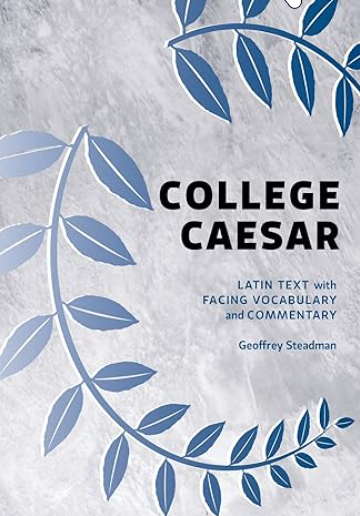 Latin is not dead and can decode many languages and subjects throughout schooling. It provides the root words for all modern sciences, is the language of law, government, logic and theology, and is the key to unlock all of the romance languages. The primary goal is for students to read and appreciate significant works of Greek and Latin authors as found in their original works. In the Great Books program students study excellent translations of these works but the study of the original works enables direct access to the thoughts and feelings of the authors themselves. As our students learn in the Great Books program, these writings are as relevant today as when they were written. Our Latin teaching follows the same methods of our Great Books seminars Latin and Greek grammar with a student-centered and discussion-based socratic approach whrein the students become their own best teachers often taking the lead in class. Students become better learners and readers by speaking, hearing and writing Latin. Once their initial studies have prepared them, they will read and study excerpts from such Roman authors as Cicero, Vergil, and Caesar.
Latin is not dead and can decode many languages and subjects throughout schooling. It provides the root words for all modern sciences, is the language of law, government, logic and theology, and is the key to unlock all of the romance languages. The primary goal is for students to read and appreciate significant works of Greek and Latin authors as found in their original works. In the Great Books program students study excellent translations of these works but the study of the original works enables direct access to the thoughts and feelings of the authors themselves. As our students learn in the Great Books program, these writings are as relevant today as when they were written. Our Latin teaching follows the same methods of our Great Books seminars Latin and Greek grammar with a student-centered and discussion-based socratic approach whrein the students become their own best teachers often taking the lead in class. Students become better learners and readers by speaking, hearing and writing Latin. Once their initial studies have prepared them, they will read and study excerpts from such Roman authors as Cicero, Vergil, and Caesar.
Ludus by Exeter Academy in New Hampshire (PDF provided by Professor – parents can print and bind locally if desired)
Via Latina by William Coe Collar 1897. (PDF provided by Professor – also available on Amazon)
College Caesar edited by Geoffrey Steadman. College Caesar. 1 May 2011.. 1 May 2011
Selections provided by Professor from other Latin authors
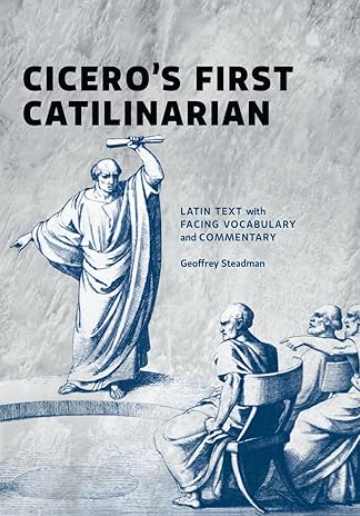 Cicero’s First Catilinarian.edited by Geoffrey Steadman, 2016
Cicero’s First Catilinarian.edited by Geoffrey Steadman, 2016
College Vergil. edited by Geoffrey Steadman, 2021.
Latin Grades 9-12 – Classical Latin 2
Prerequisite: Classical Latin I.
 This course icontinues the study of Classical Latin using excerpts from the Greek authors studied in our Great Books course. The readings covered include Cicero of 1st century A.D. who represented the height of rhetoric and combined the Roman spirit with Greek doctrine relying on many examples drawn from Greek authors studied during our Ancient Greek years. Cicero’s works were highly regarded and studied in the Church Cathedral schools and Medieval universities of the 12th and 13th centuries; the Renaissance, the Counter Reformation and American Colleges through the late 19th century. Similarly well-regarded and studied during these periods were Vergil’s works (Aeneid, Eclogues, Georgics), as well as Julius Caesar’s Conquest of Gaul. Both of these authors are read and studied during our Great Books Ancient Romans year. Accordingly, this course is classically authentic incorporating the same methods used to teach Latin from the 5th century B.C. to AD 19th century.Accordingly, this course is classically authentic incorporating the same methods used to teach Latin from the 5th century B.C. to AD 19th century. Students are connected Latin right with an introduction to Greek / Roman Mythology and Roman history.
This course icontinues the study of Classical Latin using excerpts from the Greek authors studied in our Great Books course. The readings covered include Cicero of 1st century A.D. who represented the height of rhetoric and combined the Roman spirit with Greek doctrine relying on many examples drawn from Greek authors studied during our Ancient Greek years. Cicero’s works were highly regarded and studied in the Church Cathedral schools and Medieval universities of the 12th and 13th centuries; the Renaissance, the Counter Reformation and American Colleges through the late 19th century. Similarly well-regarded and studied during these periods were Vergil’s works (Aeneid, Eclogues, Georgics), as well as Julius Caesar’s Conquest of Gaul. Both of these authors are read and studied during our Great Books Ancient Romans year. Accordingly, this course is classically authentic incorporating the same methods used to teach Latin from the 5th century B.C. to AD 19th century.Accordingly, this course is classically authentic incorporating the same methods used to teach Latin from the 5th century B.C. to AD 19th century. Students are connected Latin right with an introduction to Greek / Roman Mythology and Roman history.
 Latin is not dead and can decode many languages and subjects throughout schooling. It provides the root words for all modern sciences, is the language of law, government, logic and theology, and is the key to unlock all of the romance languages. The primary goal is for students to read and appreciate significant works of Greek and Latin authors as found in their original works. In the Great Books program students study excellent translations of these works but the study of the original works enables direct access to the thoughts and feelings of the authors themselves. As our students learn in the Great Books program, these writings are as relevant today as when they were written. Our Latin teaching follows the same methods of our Great Books seminars Latin and Greek grammar with a student-centered and discussion-based socratic approach whrein the students become their own best teachers often taking the lead in class. Students become better learners and readers by speaking, hearing and writing Latin. Once their initial studies have prepared them, they will read and study excerpts from such Roman authors as Cicero, Vergil, and Caesar.
Latin is not dead and can decode many languages and subjects throughout schooling. It provides the root words for all modern sciences, is the language of law, government, logic and theology, and is the key to unlock all of the romance languages. The primary goal is for students to read and appreciate significant works of Greek and Latin authors as found in their original works. In the Great Books program students study excellent translations of these works but the study of the original works enables direct access to the thoughts and feelings of the authors themselves. As our students learn in the Great Books program, these writings are as relevant today as when they were written. Our Latin teaching follows the same methods of our Great Books seminars Latin and Greek grammar with a student-centered and discussion-based socratic approach whrein the students become their own best teachers often taking the lead in class. Students become better learners and readers by speaking, hearing and writing Latin. Once their initial studies have prepared them, they will read and study excerpts from such Roman authors as Cicero, Vergil, and Caesar.
Ludus by Exeter Academy in New Hampshire (PDF provided by Professor – parents can print and bind locally if desired)
Via Latina by William Coe Collar 1897. (PDF provided by Professor – also available on Amazon)
College Caesar edited by Geoffrey Steadman. College Caesar. 1 May 2011.. 1 May 2011
Selections provided by Professor from other Latin authors
 Cicero’s First Catilinarian.edited by Geoffrey Steadman, 2016
Cicero’s First Catilinarian.edited by Geoffrey Steadman, 2016
College Vergil. edited by Geoffrey Steadman, 2021.
Latin Grades 9-12 – Classical Latin 3
Prerequisite: Classical Latin 2.
 This course icontinues the study of Classical Latin using excerpts from the Greek authors studied in our Great Books course. The readings covered include Cicero of 1st century A.D. who represented the height of rhetoric and combined the Roman spirit with Greek doctrine relying on many examples drawn from Greek authors studied during our Ancient Greek years. Cicero’s works were highly regarded and studied in the Church Cathedral schools and Medieval universities of the 12th and 13th centuries; the Renaissance, the Counter Reformation and American Colleges through the late 19th century. Similarly well-regarded and studied during these periods were Vergil’s works (Aeneid, Eclogues, Georgics), as well as Julius Caesar’s Conquest of Gaul. Both of these authors are read and studied during our Great Books Ancient Romans year. Accordingly, this course is classically authentic incorporating the same methods used to teach Latin from the 5th century B.C. to AD 19th century. Accordingly, this course is classically authentic incorporating the same methods used to teach Latin from the 5th century B.C. to AD 19th century.
This course icontinues the study of Classical Latin using excerpts from the Greek authors studied in our Great Books course. The readings covered include Cicero of 1st century A.D. who represented the height of rhetoric and combined the Roman spirit with Greek doctrine relying on many examples drawn from Greek authors studied during our Ancient Greek years. Cicero’s works were highly regarded and studied in the Church Cathedral schools and Medieval universities of the 12th and 13th centuries; the Renaissance, the Counter Reformation and American Colleges through the late 19th century. Similarly well-regarded and studied during these periods were Vergil’s works (Aeneid, Eclogues, Georgics), as well as Julius Caesar’s Conquest of Gaul. Both of these authors are read and studied during our Great Books Ancient Romans year. Accordingly, this course is classically authentic incorporating the same methods used to teach Latin from the 5th century B.C. to AD 19th century. Accordingly, this course is classically authentic incorporating the same methods used to teach Latin from the 5th century B.C. to AD 19th century.
 Latin is not dead and can decode many languages and subjects throughout schooling. It provides the root words for all modern sciences, is the language of law, government, logic and theology, and is the key to unlock all of the romance languages. The primary goal is for students to read and appreciate significant works of Greek and Latin authors as found in their original works. In the Great Books program students study excellent translations of these works but the study of the original works enables direct access to the thoughts and feelings of the authors themselves. As our students learn in the Great Books program, these writings are as relevant today as when they were written. Our Latin teaching follows the same methods of our Great Books seminars Latin and Greek grammar with a student-centered and discussion-based socratic approach whrein the students become their own best teachers often taking the lead in class. Students become better learners and readers by speaking, hearing and writing Latin. Once their initial studies have prepared them, they will read and study excerpts from such Roman authors as Cicero, Vergil, and Caesar.
Latin is not dead and can decode many languages and subjects throughout schooling. It provides the root words for all modern sciences, is the language of law, government, logic and theology, and is the key to unlock all of the romance languages. The primary goal is for students to read and appreciate significant works of Greek and Latin authors as found in their original works. In the Great Books program students study excellent translations of these works but the study of the original works enables direct access to the thoughts and feelings of the authors themselves. As our students learn in the Great Books program, these writings are as relevant today as when they were written. Our Latin teaching follows the same methods of our Great Books seminars Latin and Greek grammar with a student-centered and discussion-based socratic approach whrein the students become their own best teachers often taking the lead in class. Students become better learners and readers by speaking, hearing and writing Latin. Once their initial studies have prepared them, they will read and study excerpts from such Roman authors as Cicero, Vergil, and Caesar.
Ludus by Exeter Academy in New Hampshire (PDF provided by Professor – parents can print and bind locally if desired)
Via Latina by William Coe Collar 1897. (PDF provided by Professor – also available on Amazon)
College Caesar edited by Geoffrey Steadman. College Caesar. 1 May 2011.. 1 May 2011
Selections provided by Professor from other Latin authors
 Cicero’s First Catilinarian.edited by Geoffrey Steadman, 2016
Cicero’s First Catilinarian.edited by Geoffrey Steadman, 2016
College Vergil. edited by Geoffrey Steadman, 2021.
Latin Grades 9-12 – Classical Latin 4
For high school students
Prerequisite: Classical Latin 3.
 This course icontinues the study of Classical Latin using excerpts from the Greek authors studied in our Great Books course . The readings covered include Cicero of 1st century A.D. who represented the height of rhetoric and combined the Roman spirit with Greek doctrine relying on many examples drawn from Greek authors studied during our Ancient Greek years. Cicero’s works were highly regarded and studied in the Church Cathedral schools and Medieval universities of the 12th and 13th centuries; the Renaissance, the Counter Reformation and American Colleges through the late 19th century. Similarly well-regarded and studied during these periods were Vergil’s works (Aeneid, Eclogues, Georgics), as well as Julius Caesar’s Conquest of Gaul. Both of these authors are read and studied during our Great Books Ancient Romans year. Accordingly, this course is classically authentic incorporating the same methods used to teach Latin from the 5th century B.C. to AD 19th century. Accordingly, this course is classically authentic incorporating the same methods used to teach Latin from the 5th century B.C. to AD 19th century.
This course icontinues the study of Classical Latin using excerpts from the Greek authors studied in our Great Books course . The readings covered include Cicero of 1st century A.D. who represented the height of rhetoric and combined the Roman spirit with Greek doctrine relying on many examples drawn from Greek authors studied during our Ancient Greek years. Cicero’s works were highly regarded and studied in the Church Cathedral schools and Medieval universities of the 12th and 13th centuries; the Renaissance, the Counter Reformation and American Colleges through the late 19th century. Similarly well-regarded and studied during these periods were Vergil’s works (Aeneid, Eclogues, Georgics), as well as Julius Caesar’s Conquest of Gaul. Both of these authors are read and studied during our Great Books Ancient Romans year. Accordingly, this course is classically authentic incorporating the same methods used to teach Latin from the 5th century B.C. to AD 19th century. Accordingly, this course is classically authentic incorporating the same methods used to teach Latin from the 5th century B.C. to AD 19th century.
 Latin is not dead and can decode many languages and subjects throughout schooling. It provides the root words for all modern sciences, is the language of law, government, logic and theology, and is the key to unlock all of the romance languages. The primary goal is for students to read and appreciate significant works of Greek and Latin authors as found in their original works. In the Great Books program students study excellent translations of these works but the study of the original works enables direct access to the thoughts and feelings of the authors themselves. As our students learn in the Great Books program, these writings are as relevant today as when they were written. Our Latin teaching follows the same methods of our Great Books seminars Latin and Greek grammar with a student-centered and discussion-based socratic approach whrein the students become their own best teachers often taking the lead in class. Students become better learners and readers by speaking, hearing and writing Latin. Once their initial studies have prepared them, they will read and study excerpts from such Roman authors as Cicero, Vergil, and Caesar.
Latin is not dead and can decode many languages and subjects throughout schooling. It provides the root words for all modern sciences, is the language of law, government, logic and theology, and is the key to unlock all of the romance languages. The primary goal is for students to read and appreciate significant works of Greek and Latin authors as found in their original works. In the Great Books program students study excellent translations of these works but the study of the original works enables direct access to the thoughts and feelings of the authors themselves. As our students learn in the Great Books program, these writings are as relevant today as when they were written. Our Latin teaching follows the same methods of our Great Books seminars Latin and Greek grammar with a student-centered and discussion-based socratic approach whrein the students become their own best teachers often taking the lead in class. Students become better learners and readers by speaking, hearing and writing Latin. Once their initial studies have prepared them, they will read and study excerpts from such Roman authors as Cicero, Vergil, and Caesar.
Ludus by Exeter Academy in New Hampshire (PDF provided by Professor – parents can print and bind locally if desired)
Via Latina by William Coe Collar 1897. (PDF provided by Professor – also available on Amazon)
College Caesar edited by Geoffrey Steadman. College Caesar. 1 May 2011.. 1 May 2011
Selections provided by Professor from other Latin authors
 Cicero’s First Catilinarian.edited by Geoffrey Steadman, 2016
Cicero’s First Catilinarian.edited by Geoffrey Steadman, 2016
College Vergil. edited by Geoffrey Steadman, 2021.

